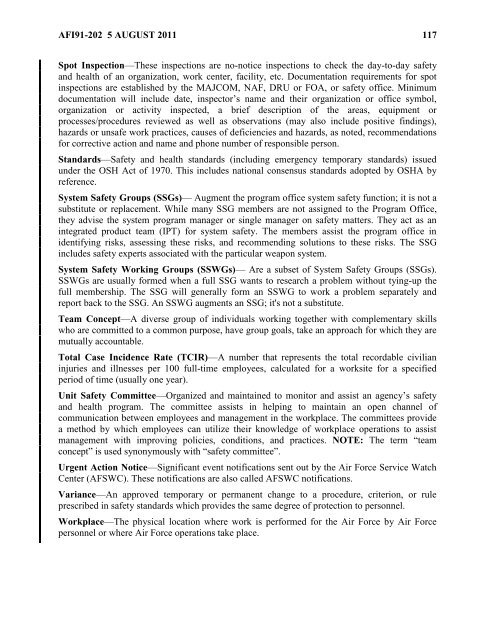MEMORANDUM FOR A1 - Air Force E-Publishing
MEMORANDUM FOR A1 - Air Force E-Publishing
MEMORANDUM FOR A1 - Air Force E-Publishing
Create successful ePaper yourself
Turn your PDF publications into a flip-book with our unique Google optimized e-Paper software.
AFI91-202 5 AUGUST 2011 117<br />
Spot Inspection—These inspections are no-notice inspections to check the day-to-day safety<br />
and health of an organization, work center, facility, etc. Documentation requirements for spot<br />
inspections are established by the MAJCOM, NAF, DRU or FOA, or safety office. Minimum<br />
documentation will include date, inspector’s name and their organization or office symbol,<br />
organization or activity inspected, a brief description of the areas, equipment or<br />
processes/procedures reviewed as well as observations (may also include positive findings),<br />
hazards or unsafe work practices, causes of deficiencies and hazards, as noted, recommendations<br />
for corrective action and name and phone number of responsible person.<br />
Standards—Safety and health standards (including emergency temporary standards) issued<br />
under the OSH Act of 1970. This includes national consensus standards adopted by OSHA by<br />
reference.<br />
System Safety Groups (SSGs)— Augment the program office system safety function; it is not a<br />
substitute or replacement. While many SSG members are not assigned to the Program Office,<br />
they advise the system program manager or single manager on safety matters. They act as an<br />
integrated product team (IPT) for system safety. The members assist the program office in<br />
identifying risks, assessing these risks, and recommending solutions to these risks. The SSG<br />
includes safety experts associated with the particular weapon system.<br />
System Safety Working Groups (SSWGs)— Are a subset of System Safety Groups (SSGs).<br />
SSWGs are usually formed when a full SSG wants to research a problem without tying-up the<br />
full membership. The SSG will generally form an SSWG to work a problem separately and<br />
report back to the SSG. An SSWG augments an SSG; it's not a substitute.<br />
Team Concept—A diverse group of individuals working together with complementary skills<br />
who are committed to a common purpose, have group goals, take an approach for which they are<br />
mutually accountable.<br />
Total Case Incidence Rate (TCIR)—A number that represents the total recordable civilian<br />
injuries and illnesses per 100 full-time employees, calculated for a worksite for a specified<br />
period of time (usually one year).<br />
Unit Safety Committee—Organized and maintained to monitor and assist an agency’s safety<br />
and health program. The committee assists in helping to maintain an open channel of<br />
communication between employees and management in the workplace. The committees provide<br />
a method by which employees can utilize their knowledge of workplace operations to assist<br />
management with improving policies, conditions, and practices. NOTE: The term ―team<br />
concept‖ is used synonymously with ―safety committee‖.<br />
Urgent Action Notice—Significant event notifications sent out by the <strong>Air</strong> <strong>Force</strong> Service Watch<br />
Center (AFSWC). These notifications are also called AFSWC notifications.<br />
Variance—An approved temporary or permanent change to a procedure, criterion, or rule<br />
prescribed in safety standards which provides the same degree of protection to personnel.<br />
Workplace—The physical location where work is performed for the <strong>Air</strong> <strong>Force</strong> by <strong>Air</strong> <strong>Force</strong><br />
personnel or where <strong>Air</strong> <strong>Force</strong> operations take place.
















